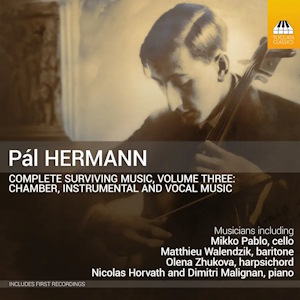
Pál Hermann (1902-1944)
Complete Surviving Music Volume 3 – Chamber, Instrumental & Vocal Music
rec. 2023, La Fabrique des rêves; Steppenwolf Studio, Asch; Studio of the National Bandurist Chorus of Ukraine, Kyiv; Lviv Organ Hall; Recital Studio B, Huy
Texts and translations included
Toccata Classics TOCC0623 [68]
This is the third and final volume devoted to Pál Hermann’s complete surviving music. Reviews of the two previous volumes (Volume 1 ~ Volume 2) will fill out the biography of the eminent but now all-but-unknown cellist-composer who formed an admired and long-standing duo with violinist Zoltán Székely. This final volume is something of a mopping-up operation with a sequence of smaller works for various instrumental combinations, for solo piano – and other instruments – and songs. The variety and nature of the instrumentation can be inferred when looking at the large personnel enlisted for this venture which was recorded at various locations in Belgium, the Netherlands and Ukraine.
As well as his role as a leading cellist he’d also studied composition with Bartók and Kodály and their influence was to remain pivotal though subject to mutation and adjustment in the light of prevailing fashions. The solo piano works, for example, reflect these varying influences. The earliest, the Allegro dates from 1920 and is suffused in Bartókian Barbaro – rugged and bad-tempered – whilst the Toccata is more impressionistic and French and includes an insouciant little popular-sounding tune. The Epigrammes were written soon after the tragic death of his wife and are rather droll in a neo-classical kind of way. Pièces pour piano à quatre mains dates from 1939, possibly his last composition, as he was murdered in 1944. These little character pieces offer charming opportunities for beginners or children.
In his Berlin years in the 1920s he was a member of several pioneering early music ensembles and performed with the Berliner Cembalo Trio and with harpsichordist Alice Ehlers. It’s very likely that he composed a series of works for this kind of ensemble. The Suite for Three Recorders is a rather easy-going essay, supple but repetitive but the Sarabande for Lute is rather more musically distinguished, though brief. On a more expansive span is the Divertissement for Harpsichord, with lucid textures and neo-classical in feel but with sufficient dissonances and acidic moments to keep expectation at a premium. Once again, Hermann shows his demotic flair when encoding songful qualities into his music and one movement sounds like a children’s song. Perhaps this work was intended for Ehlers?
Brief works for organ and for horn and piano are of rather more archival interest than musical though the two songs for baritone and piano show a Gallic affiliation. A bigger work for singer is Ophélie of which an orchestrated version can be heard in volume 1 of this series. It’s an intense setting of a poem by Rimbaud in which Ophelia ‘floats like a great lily/Floats very slowly, bedded in her long veils…’ When one reflects that Hermann’s wife died of pneumonia after swallowing sea water whilst swimming, then the nature of that intensity becomes more obvious and very much more personal.
A trio of arrangements ends the disc, redolent of Weimar frolics as well as providing novel encore fodder for the cellist.
The performances are attractive, the various recording locations sympathetic and Dimitri Malignan’s booklet notes ever-excellent. Whilst this is clearly the least essential volume in the Hermann series it does helpfully focus on some important areas in his life, not least those ‘early music’ years, and his flirtations with neo-classicism and impressionism, as well as presenting Ophélie in its original form.
Jonathan Woolf
Help us financially by purchasing from


Contents
Allegro for piano solo (1920)
Toccata for piano solo (1936)
Quatre Épigrammes for piano solo (1934)
Pièces pour piano à quatre mains (1939)
Zeven kippen hebben wij for five voices (1930)
Suite for three recorders (c. 1930)
Sarabande for lute (c. 1930)
Divertissement for harpsichord (1938)
Inventio for organ (1920)
Allegretto for horn and piano (1920)
La Ceinture for baritone and piano (1934)
La Dormeuse for baritone and piano (1934)
Ophélie for baritone and piano (1939)
Henry Marshall, Richard Whiting and Raymond Egan
Somebody’s Wrong: Foxtrot for violin and cello (1923) arr. Pál Hermann
Franz Schubert (1797-1828)
Moment Musical, D. 780: No. 3 for cello and piano (publ. 1828) arr. Pál Hermann
Fryderyk Chopin (1809-1847)
Grande Valse brillante, Op. 18 for cello and piano (1833) arr. Hermann
Performers
Nicolas Horvath (piano): Dimitri Malignan (piano): Elizaveta Agrafenina (soprano), Sára Gutvill (mezzo-soprano), Irina Bedicova (mezzo-soprano), Paul van Gastel (tenor), Pierre Mak (baritone): Matthieu Walendzik (baritone): Reine-Marie Verhagen (soprano recorder), Inês d’Avena (alto recorder), Dante Jongerius (tenor recorder): Punto Bawono (Baroque lute): Olena Zhukova (harpsichord): Olena Matselyukh (organ): Jean-Pierre Dassonville (horn): Sadie Fields (violin): Mikko Pablo (cello)

















